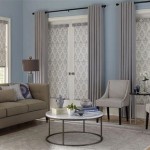How Much Does An Interior Designer Get Paid A Year?
Determining the annual salary of an interior designer requires considering a multitude of factors. The profession is dynamic and compensation varies significantly based on experience, location, specialization, education, the type of employment, and the overall economic climate. While pinpointing an exact average is challenging, this article will explore the key elements that influence an interior designer's earning potential and provide a comprehensive overview of the salary landscape.
The base salary figures often reported by online resources provide a general starting point, but they rarely paint a complete picture. These figures often represent averages derived from self-reported data, which may not accurately reflect the entire profession. Furthermore, the reported "average" salary might not account for benefits packages, freelance income, or performance-based bonuses, all of which contribute to an interior designer's overall annual income.
For instance, an entry-level interior designer just starting their career with a bachelor's degree and limited experience might earn a significantly lower salary compared to a seasoned professional with decades of experience, a master's degree, and a proven track record of successful projects. Similarly, an interior designer working for a small, boutique firm in a rural area will likely earn less than someone employed by a large, well-established architectural firm in a major metropolitan city.
Understanding these variables is crucial when assessing potential earning expectations for a career in interior design. Aspiring interior designers should carefully research the specific factors relevant to their individual circumstances and career goals to gain a realistic understanding of the salary potential in their desired field.
Experience Level: The Dominant Factor
Perhaps the most significant determinant of an interior designer's salary is their level of experience. As with most professions, experience translates directly into increased expertise, efficiency, and the ability to manage more complex and demanding projects. Entry-level positions often serve as a stepping stone, providing designers with foundational skills and exposure to the industry's practical aspects.
Entry-level interior designers, typically defined as those with 0-3 years of experience, usually assist senior designers with tasks such as drafting, space planning, material selection, and client communication. Their compensation typically reflects their limited experience and the supervised nature of their work. Starting salaries can range considerably, but generally, they fall within the lower spectrum of the profession's earning potential.
Mid-career interior designers, with approximately 5-10 years of experience, have typically developed a strong portfolio of completed projects and possess a deeper understanding of the design process. They are often capable of managing projects independently, leading teams, and interacting directly with clients. Their salaries reflect this increased responsibility and expertise, often seeing a substantial increase from their entry-level counterparts.
Senior-level interior designers, possessing over 10 years of experience, are considered experts in their field. They often hold leadership positions within their firms, overseeing multiple projects, mentoring junior designers, and contributing to the firm's overall strategic direction. Senior designers command the highest salaries, reflecting their extensive experience, proven track record, and ability to generate significant revenue for their employers.
The earning potential for experienced designers also stems from the ability to secure larger, more profitable projects. Their expertise in project management, budget control, and client relations allows them to handle complex and high-value projects, which in turn translates into higher fees and ultimately, increased compensation for the designer.
Location, Location, Location: The Geographic Impact
The geographic location of an interior designer's employment plays a crucial role in determining their salary. Major metropolitan areas, such as New York City, Los Angeles, and Chicago, typically offer higher salaries compared to smaller cities or rural areas. This disparity is primarily driven by the higher cost of living in these urban centers, as well as the greater demand for interior design services in these areas.
In cities with a thriving real estate market and a strong economy, the demand for interior designers is generally higher. This increased demand translates into more job opportunities and higher salaries, as firms compete to attract and retain talented designers. Furthermore, these cities often have a concentration of high-end residential and commercial projects, which command higher fees and ultimately contribute to increased earning potential for designers.
Conversely, in areas with a lower cost of living and a less robust economy, the demand for interior design services may be lower, resulting in lower salaries. While the cost of living may be lower, the overall earning potential can be significantly less than in major metropolitan areas. It's important to consider the trade-off between cost of living and earning potential when evaluating job opportunities in different locations.
Regional variations also exist within the United States. States like California and New York, with their affluent populations and vibrant design industries, tend to offer higher salaries compared to states in the Midwest or the South. Understanding these regional differences is important when assessing the salary landscape and making career decisions.
Even within a specific metropolitan area, salary variations can occur based on the neighborhood or district where a design firm is located. Firms located in affluent areas or in commercial districts with a high concentration of corporate clients may offer higher salaries compared to firms located in less affluent areas.
Specialization and Niche: Carving Out Earning Potential
Interior design is a broad field, encompassing various specializations and niches. The specific area of focus an interior designer chooses can significantly impact their earning potential. Certain specializations are in higher demand or command higher fees due to the complexity of the projects or the specialized knowledge required.
For example, commercial interior designers specializing in corporate office design or healthcare facilities often earn higher salaries compared to residential interior designers. Commercial projects tend to be larger in scale, more complex in scope, and require a deeper understanding of building codes, regulations, and accessibility standards. The expertise required to manage these projects translates into higher compensation.
Luxury residential design also presents a significant earning opportunity. Designers specializing in high-end residential projects often work with affluent clients who are willing to invest substantial sums in creating unique and sophisticated living spaces. These projects often involve custom furniture design, high-end materials, and meticulous attention to detail, all of which contribute to higher fees and increased earning potential.
Sustainable design, also known as green design, is another specialization that is gaining increasing prominence. As environmental awareness grows, the demand for designers with expertise in sustainable materials, energy-efficient design strategies, and LEED certification is increasing. Designers specializing in sustainable design often command higher fees due to their specialized knowledge and the value they bring to projects seeking to minimize their environmental impact.
Furthermore, specialization in specific types of spaces, such as retail environments, hospitality venues, or educational institutions, can also lead to increased earning potential. Each of these areas requires a unique set of skills and knowledge, and designers who specialize in these areas often develop a deep understanding of the specific needs and requirements of these spaces.
Finally, the ability to offer specialized services, such as 3D rendering, virtual reality design, or project management, can also enhance an interior designer's earning potential. These additional skills and services can make a designer more valuable to their firm or clients, allowing them to command higher fees and secure more profitable projects.
In summary, the annual salary of an interior designer is influenced by a complex interplay of factors. Experience level, geographic location, and specialization are among the most significant determinants. By carefully considering these variables and developing a strategic career plan, aspiring and practicing interior designers can maximize their earning potential and achieve their financial goals.

How Much Does An Interior Designer Make Breaking Down Salaries Tips On To Earn More Money

Interior Designer Salary Neit

How To Become An Interior Designer Ici

Interior Designer Statistics Facts And Career Trends

How Much Does An Interior Designer Cost Pacaso

Average Interior Designer Salary Guide 2024 Us Data Logistis

How Much Does It Cost To Hire An Interior Designer Sfd

Become An Interior Designer In 2024 Salary Jobs Pay Degree
What S The Fastest Way To Make Money As An Interior Designer Designed

The 2 Ways Interior Designers Make Money
Related Posts








